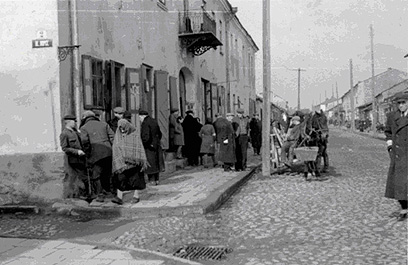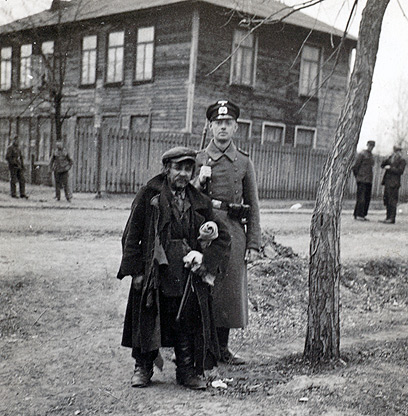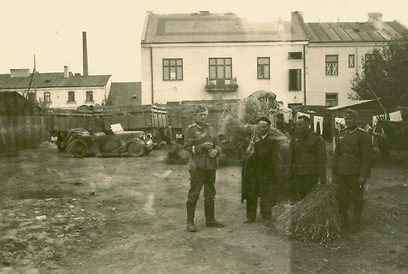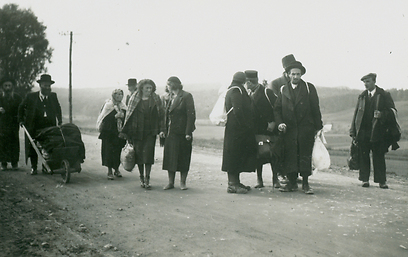
Rare Shoah images from Nazi albums
Pictures of daily Jewish life during Holocaust hidden in private albums of Wehrmacht soldiers for years. Dariusz Dekiert, a devout Christian from Poland, locates and hands them over to Shem Olam Institute. 'I see it as rectification,' he tells Yedioth Ahronoth
It is a picture of Jewish children during the Holocaust. The photographer is a German Wehrmacht soldier. One frozen moment in the hell Europe's Jews went through.

This picture shows Jewish children being forced to give German soldiers a Nazi salute. The children are smiling, perhaps having no other choice, and appear not to understand that they have become a pawn in the hands of soldiers who have lost their humanity
The Shem Olam Institute launched a special project in the past year, collecting photos of Jews from the Holocaust. These are not the famous propaganda pictures, but rather photos kept in the private albums of German troops, who documented their service like any other soldier.
Most album owners, Shem Olam officials say, seek to get rid of the pictures linking their family members to Nazi Germany.

During the invasion of Poland, photographer Leni Riefenstahl was in the town of Końskie while 30 citizens were being executed in revenge for an alleged revolt against German soldiers. According to her memoirs, Riefenstahl tried to stop the execution but an angry German soldier threatened to shoot her on the spot. She claimed she did not know the victims were Jewish. This picture shows the building next to which the Jews were shot to death


Forced labor in Radom, a city in central Poland

This photo from the Warsaw Ghetto appears to be staged. German soldiers likely came across the synagogue and ordered the worshippers to pose for a picture

General photos. The German soldiers kept their pictures in the album alongside the pictures they took of Jews

On the stairs of the Sages of Lublin Yeshiva. A German soldier photographed a singing group playing for passersby outside the ghetto. The Sages of Lublin Yeshiva was the most famous Jewish institutions at the time and was abandoned after all Jews were pushed into the ghetto
_wa.jpg)
The burning of the synagogue in Kotzk. This 1941 photos shows the Jewish synagogue on fire. These pictures were attached to photos in which German soldiers documented the collection of gravestones from the Kotzk cemetery, apparently for the purpose of construction or paving roads. The phenomenon of torching synagogues in Poland was well-known, but there is hardly any documentation of these incidents

A convalescence facility for German soldiers. The Germans brought Jews to the facility to wash their cars and engage in other humiliating jobs. This picture and others point to the fact that they purposely brought in weaker men


Warsaw Ghetto. Hundreds of pictures of the ghetto's streets were found during the search, revealing the Jews' daily life


A Jewish child's funeral in 1941, in a small town in Poland which did not have an organization handling burial arrangements. The soldiers came across an improvised funeral procession held by the family of a little boy

The soldier sitting in the car passed by Jewish villages and towns and took pictures of the people he encountered. It seems that they weren't afraid of him and cooperated with the picture taking

A German soldier with a Jew. From time to time, the German soldiers ran into a Jew whose appearance matched the Nazis' brainwashing. When they came across colorful people, they rushed to pose for a picture with them in order to present the Aryan race next to the 'inferior race'

Forced labor in Krakow. Soldiers supervising the forced labor took a series of pictures showing Jews in the camps. Some of those Wehrmacht soldiers took pictures of the same people over time, so the pictures can teach us quite a lot about their lives

Forced labor in Krakow

German soldiers destroying a cemetery in the Rzeszów. The Germans often used the tombstones as construction material, as can be learned from the documents and pictures found. Sometimes bids were issued for Polish contractors to destroy the gravestones in order to use the marble and stone
Some of the pictures have the original caption written by the soldiers. In other cases, an inquiry was required to understand them. Some of the soldiers documented the same people time and again, teaching us quite a lot about the daily life of the photographed Jews. Others just documented the people and stories they came across.
In some pictures the Jews seem unafraid of the soldiers. In others, their facial expressions point to fear, embarrassment and humiliation.
The story of the man who found these pictures is as fascinating as the photos themselves. Dariusz Dekiert, a 39-year-old Polish citizen who visited Israel this week as a guest of the Shem Olam Institute, is a devout Christian. Locating more and more items from those dark days has virtually become his life's work.
"I have a feeling that this world has chosen me," he says. "All I wanted to do was learn, and the science of Judaism was the subject I found easiest to get into. So I started learning and was drawn in."



Photo taken in Radom

Radom

Krakow

Końskie

Końskie

Stanislaw



Lublin

Lublin

Lviv

Zamość

Zamość

Warsaw

Warsaw

Warsaw

Warsaw


Album caption – Warsaw Ghetto




Dariusz quickly learned Hebrew, Yiddish and even Aramaic, in a bid to translate the Talmud into Polish in the future. After completing his studies he settled in Lodz. He worked as a lecturer at the university, and after being authorized by the Polish justice minister to work as a professional translator he founded a company offering Hebrew-to-Polish and Polish-to-Hebrew translations.
His current job, he tells Yedioth Ahronoth, combines his great loves – history, geography and Judaism.
"As part of my work I locate documents, photos, objects and historical material which were left in Poland and are now in private hands, and hold negotiations to obtain them," he says. "It involves a lot of patience and negotiation skills. In Poland and Germany there are tens of thousands of pictures of Jews taken by German soldiers who have already aged or died."
What is the most emotionally moving item you found?
"A suitcase that arrived from the Lodz Ghetto, which I bought from a private person. It was empty and appeared to have been through hardships, and it had a clue leading to a name I couldn't identify. The person who sold it to me said his father had stolen it from Jews who got on the train to Auschwitz. After searching for a long time, the Shem Olam Institute managed to locate relatives of the suitcase owners in Israel, and the fact that it was returned to Jewish hands moved me to tears.
"Another object I was moved by was a jewel created from two Polish coins combined together. The bridge of the Lodz Ghetto was sketched on the rear side of the coins with the inscription, 'To my beloved mother.' Unfortunately, we have no way of locating the source of the jewel."
Today Dariusz lives near the Jewish community in Lodz. "I see my work as rectification," he says, "especially when it comes to returning the pictures of Jews during the Holocaust to Jewish hands."
And what does your family think about your job?
"At first they found it odd, but they've gotten used to it by now."
The Shem Olam Institute was founded in 1996 by Rabbi Avraham Krieger and is located in the central Israeli moshav of Kfar Haroeh.
The institute, which has more than 800,000 documents and exhibits, engages in the exposure and analysis of issues of spirit and faith and how individuals and communities coped during the Holocaust.










